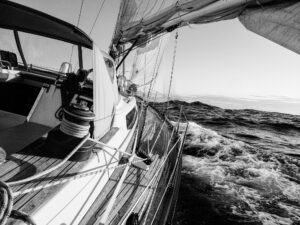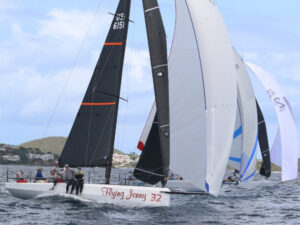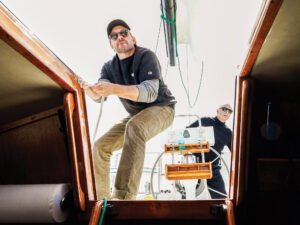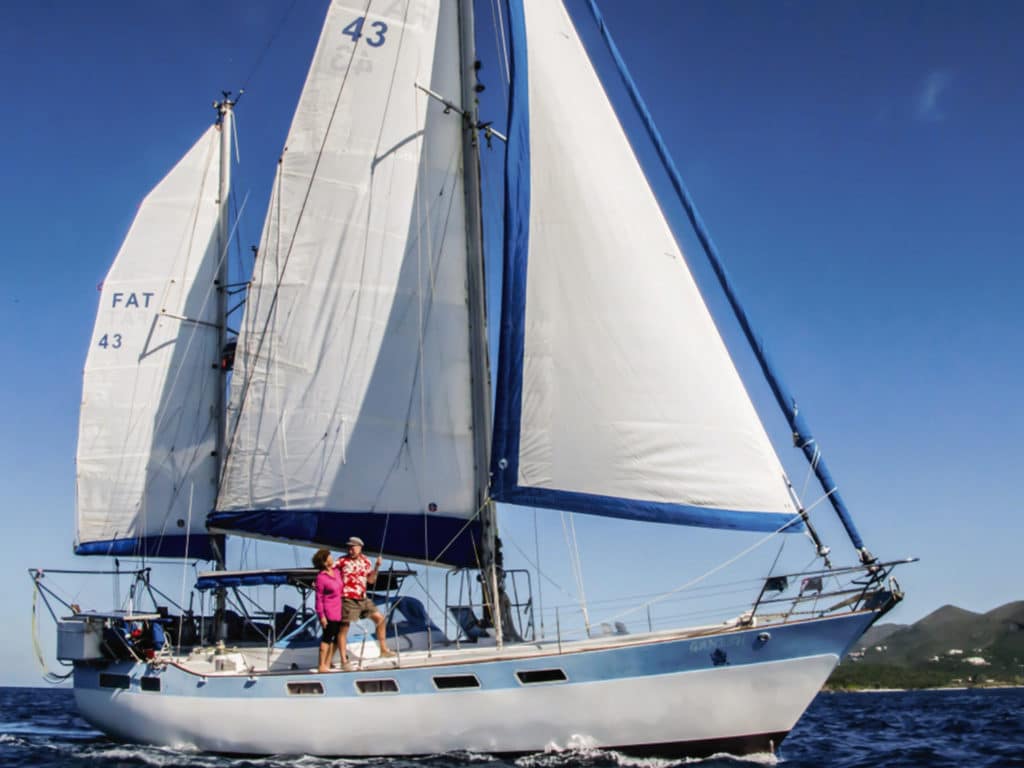
There are three situations where I greatly appreciate my old-fashioned ketch rig on our present boat, Ganesh: under sail, under power and while anchored. Truth be told, for the entire 23 years that I owned my sloop-rigged S&S-designed Wild Card, I had mizzen envy. Sad!
What, in layman’s terms, is a ketch? Basically, it is a sloop with slightly smaller main and jib set slightly more forward on a main mast, with a mizzen sail aft that’s carried on a second spar. Thus, the ketch has roughly the same sail area spread over a longer span and in smaller chunks. What’s the difference between a ketch and a yawl? The ketch has a comparatively larger mizzen than the yawl, and the ketch’s mizzen mast is set forward of where the rudder post bisects the waterline rather than aft of it.
What good is a mizzen mast at anchor? Plenty good! One, it can hold cool stuff such as nav lights, aft-deck spreader lights, anchor light, radar dome, PA speakers, wind generator, exterior stereo speakers and a radar reflector. It also serves as a small hoisting crane aft. We can haul up our 9.8 hp Tohatsu outboard using our mizzen boom—though some boats require a boom extension (think sliding pole inside) to do so easily. Some skippers clap a block and tackle on the mizzen if they need to hoist an injured crewmember back aboard.
Anything else? Sure! With the mizzen sail hoisted, it can passively dampen the roll in two ways: through air resistance and by changing the vessel’s angle to the swell. Will the mizzen eliminate anchorage roll? No, but at times it can make a considerable difference by knocking the boat off its natural roll period, with dramatic effect.
Just recently, we were anchored in a windy harbor in Indonesia, with a building breeze and an increasing swell working its way around the point. In the early morning we were fine, but by midday, we were uncomfortable moving around below. My first move was to hoist our fully battened mizzen with decent halyard and outhaul tension, then sheet it home hard. (It is intentionally cut flat.) Next, I added two preventers to the boom ends to immobilize it.
RELATED: On Watch: Clearing In
This made a noticeable difference, and I forgot about the roll until later that afternoon when the wind was really piping up and the sea had built accordingly. My next move was to run a line forward from the mizzen boom end to the bow, and crank the mizzen boom to the side I wanted the boat to turn. This further steadied the vessel in two ways. First, it made the bow turn more into the swell, which reduced the roll. Second, it put a constant additional wind pressure into the mix. Both helped steady the boat.
Of course, if the wind had built further, I’d have deployed my twin flopper-stoppers from my two downwind pole ends. But in this case, just the mizzen was ample enough to dampen the roll into an OK-we-can-live-with-it zone.
Some people think of the mizzen mast as an obstruction. I think of it as something to hold on to, clip on to, and brace against. I even like the mizzen shrouds—one last chance to catch a handhold before the deep blue sea.
In many instances, I think of my mizzen sail as an air rudder. Simply by sheeting it in and easing it out, I can change the center of effort of the sails in relationship to the hull’s center of lateral resistance. That’s something a sloop cannot do as readily.
If I need to drift straight backward from a mooring, I hoist the full mizzen and full staysail, and put crew on both to pull and push as I steer backward. It is amazing how far I can get astern before my bow pays off in a consistent moderate breeze.
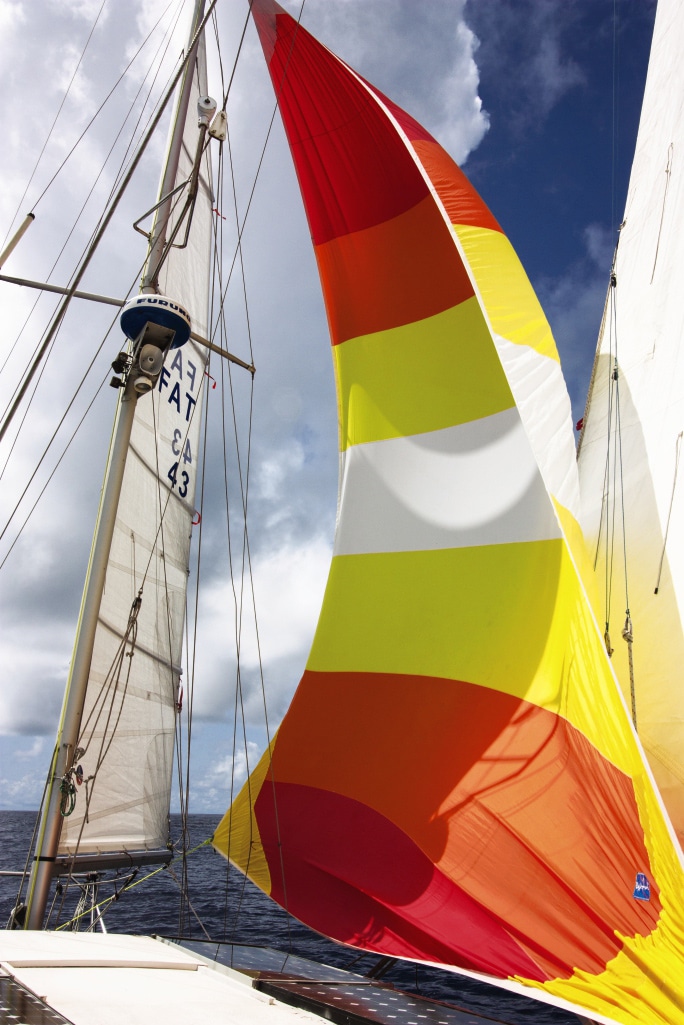
When sailing off the hook with the mizzen, I can always be sure of which tack I will pay off on. If this isn’t too important, I just turn the helm and push the mizzen boom to the desired side. If it is important, I pre-rig and pre-cant the vessel by running a line forward from the mizzen boom end through the bow hawsehole and adjust the sail accordingly.
I’ve seen schooners in Maine reverse under sail quite a way. But the very best at this was Garry Hoyt on his Freedom 40 cat ketch. Why, he could back up that “ting, mon” like a car, during Antigua Sailing Week.
I’m now 68 years old, and I must admit, my heavy mainsail is beginning to intimidate me. As a result, my wife, Carolyn, and I seldom fly it. If broad- reaching, we toss up our nylon mizzen staysail instead. It is almost the same size, and is a snap to hoist and douse in comparison to the main.
While I don’t usually carry my mizzen staysail dead downwind because of the efficiency of my twin downwind trade-wind jibs, I do occasionally carry it on a beam reach.
The thing I like best about a ketch is being able to, in heavy air, just get rid of the mainsail, and still sail well under mizzen and staysail, with the ability to tack smartly even in a lull. Yes, we can round down and jibe as well, but this takes considerably more sea room.
But if I’m sailing into a harbor or onto a mooring with Ganesh and the wind is moderate to fresh, I come in under jib and jigger (the term we used back in the day) with good control.
Of course, a mizzen takes some getting used to, especially if you’re using a windvane for steering. Most windvanes don’t like mizzens or mainsails; they want all the sails far forward for easier steering. In gusty conditions, I have to take down my mizzen while broad-reaching; if I don’t, the boat will attempt to round up.
However, on Ganesh, I’m often able to fly the mizzen while our Monitor windvane steers dead downwind in moderate conditions, perhaps because of our nearly full keel. Regardless of gusts, there is seldom a problem flying a properly sized mizzen (we have three sets of reefs), with the wind from beam-on to closehauled.
Since the mizzen is so easy to hoist and douse, we use it a lot. Its steadying force often helps the efficiency of our other sails.
Let’s be honest. As a cruiser, I’m not tweaking my vessel nearly as much as when I’m on the racecourse. In fact, while underway, over half the time I adjust my sail controls, it isn’t to go faster but to go better: with less chafe, roll and noise.
What’s the downside of a ketch? Basically, speed. Two sails of a given total square footage are more efficient than three adding up to the same size. There’s also more weight aloft and aft, both bad locations that promote hobby horsing and wallowing.
If the ketch isn’t well- designed, the mainsail will backwind the mizzen, and the only solution will be to drop the smaller sail or head lower on your course.
However, a properly designed modern ketch can be very weatherly, and develop enough extra horsepower off the wind to pay for itself.
The mizzen mast, shrouds and sails all have windage. There’s no denying that. If I was going to sail primarily upwind or in light air, I would not consider a traditional ketch. Why lug around the extra gear to little advantage?
However, as a serial circumnavigator and confirmed trade-wind sailor, all the windage of the mizzen is just additional sail area 99 percent of the time.
The real day in, day out advantage of the mizzen is that you can easily dial in your weather helm. Is the rudder fighting you in the gusts and does your vessel want to round up? If so, just ease the mizzen until the helm is almost (but not quite) neutral. It’s one string, right? Easy peasy, no?
Do you have lee helm and the boat feels like it is almost refusing to go to windward? If so, sheet in the mizzen until a faint weather helm emerges. (Test this by letting go of the wheel or tiller and watching the boat slowly round up.)
In light air, a ketch offers few advantages, and in light air to windward, even fewer still. But let the breeze pipe up and a ketch comes into its own. Smaller sails are easier to douse, furl and stow. Once the mainsail is taken care of and the jib is rolled up, the mizzen and staysail can drive our vessel through a gale with relatively little force on the mainmast, shrouds and stays.
This also means Ganesh stays more upright. No sailor likes to live on his ear for too long on passage.
Both mizzen and staysail sails are inboard and thus easy to handle in hard conditions. Our mizzen is not only fully battened, but also has lazy jacks to guide it into its stack pack, making the sail a dream to douse from a broad reach to closehauled. (However, with the battens and a large roach, the sail can be a handful if I attempt to douse it dead downwind in heavy air.)
Different mizzen masts are stayed differently. Ours has a big footprint on deck with running backstays for use in gale-force conditions. It is strong. How strong? We often heave to under mizzen alone without worry, in winds ranging from 15 to 33 knots. This isn’t as safe as heaving to with our storm trysail, but it’s a good, quick-and-dirty way to ride out a sustained squall.
Another cool thing is that we can easily remove our tabernacle-stepped mizzen spar by tilting it aft and controlling it with the higher main halyard while lowering it, all the while with the loose shrouds attached.
We even use the mizzen under power to dampen our roll because it is the quickest and easiest sail to deploy.
Of course, everything is relative. There can be too much of a good thing. I know a guy who tosses up a mizzen mast on every sloop that he buys—an installation that is trickier than it might appear. But on a well-designed sloop, a mizzen isn’t needed because of the location of the single mast, while on a ketch it is needed by design, given where the main is set.
To my mind, our mizzen mast really pays for itself aboard Ganesh, as it does on other old-fashioned, two-masted cruising tubs. In fact, I write these words on deck under an awning held up by—you guested it—my mizzen boom!
Cap’n Fatty and Carolyn Goodlander are currently cruising Southeast Asia.

